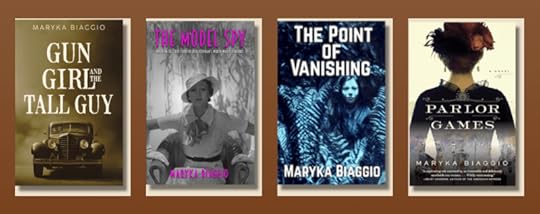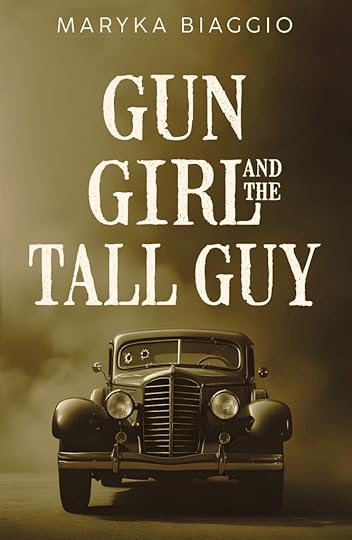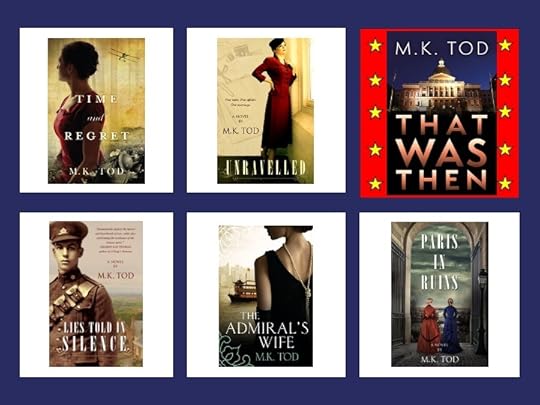The Compelling World of True-Crime Historical Fiction
Author Maryka Biaggio is known for writing historical fiction inspired by real people whose lives illuminate the complexities of their time. She is the author of five novels. Her latest novel – Gun Girl and the Tall Guy – brings the true story of audacious robbers Celia and Ed Cooney to life amidst the world of 1920s Brooklyn. Don’t you love the title?
Here’s Maryka to talk about the world of true-crime historical fiction.
The Compelling World of True-Crime Historical Fiction: Why We Can’t Look Away by Maryka Biaggio
True-crime fiction has become a cultural phenomenon, captivating readers across generations with its unique blend of intrigue, psychological depth, and narrative tension. There are countless movies and television shows about true crime, and it’s a popular book genre, too. What drives our seemingly insatiable appetite for stories that delve into the darker corners of human behavior?
Before I started writing fiction, I was a psychology professor and clinical psychologist. So I can’t help but consider motivation, personality, and temperament when I’m considering subjects for my novels and writing characters. And that includes my perspective on true-crime historical fiction.

At the heart of true crime’s appeal is a complex psychological fascination. These stories offer readers a safe environment to explore the extremes of human nature. Most people lead law-abiding lives. Even if tempted by someone who, for instance, offers a big score with a bank robbery, most of us would turn down the offer for any number of reasons: religious beliefs, fear of punishment, aversion to social censure, and/or just plain ethical/moral principles. But that doesn’t keep us from wondering: What kind of people do succumb to the temptation or even seek out the adventure of crime?
True-crime fiction takes the reader inside the crime—into the mind, motives, and, yes, the possible apprehension of the criminal. The thrill of the chase, the unfolding of clues, and the suspenseful twists pull readers in. Moreover, these narratives often present compelling moral puzzles. They challenge our understanding of good and evil, demonstrating that human behavior exists in nuanced shades of gray. By presenting thoroughly researched accounts of crimes, authors invite readers to suspend judgment and engage in deeper psychological analysis of criminals.
The intellectual challenge of understanding criminal behavior also plays a significant role in our attraction to these stories. Readers become amateur detectives of sort, piecing together evidence, examining motivations, and attempting to comprehend the seemingly incomprehensible. Who doesn’t thrill to the vicarious experience of playing Sherlock Holmes or Miss Marple?
There’s also the appeal of justice and resolution and what psychologists call the just-world hypothesis, the tendency to believe that people generally get what they deserve. This cognitive bias leads us to think that good things happen to good people, and bad things happen to bad people. It’s a way of understanding the world that provides a sense of order, predictability, and control. So when criminals are apprehended and brought to justice, it’s because they deserved to be caught; all is right with our world. If we conduct ourselves in an honest and principled matter, we can expect no ill to come to us. (Of course, there’s a downside to this cognitive bias: We don’t really have control over what fate has in store for us. Bad things happen to good people all the time, and we really shouldn’t blame people who, by no fault of their own, for instance, become victims of crime.)
Of course, not all criminals are apprehended, and many historical crimes went unsolved or were shrouded in controversy. Just browse the numerous true-crime lists at Goodreads, and you’ll find scores of novels about Al Capone, Lizzie Borden, Bonny and Clyde, and the like. These fictionalized retellings allow authors to explore possible solutions, reimagine events, or even give voice to forgotten victims.
Historical crime fiction reveals not just individual psychological profiles but also social contexts that shaped criminal behaviors. They provide insight into how past societies viewed crime, morality, and punishment. Readers might learn about the moral hypocrisies of the Victorian era, the corrupt law enforcement of the Gilded Age, or the violent underworld of Prohibition. These historical settings provide a deeper understanding of how societies functioned and how justice—or lack thereof—was meted out.
In writing my novel Gun Girl and the Tall Guy, I had to grapple with many questions: How can I accurately portray the crime spree of this young couple without romanticizing their criminal activity? Why do people sometimes delight in hearing about successful heists? Are there ever any good reasons for stealing? What role do socioeconomic factors play in shaping criminal behavior? I hope I have painted a realistic portrait of the real people featured in Gun Girl and the Tall Guy, but ultimately it’s the reader who must answer all these questions.
I do believe that true-crime fiction is more than mere sensationalism. It’s a profound exploration of human complexity, social dynamics, and the intricate mechanisms of justice and morality.
Many thanks, Maryka. I too enjoy discovering the motivations of those who commit crime along with understanding the circumstances that drive their behaviour.
Maryka Biaggio’s most recent novel, Gun Girl and the Tall Guy, is available from Bookshop.org and on Amazon.

1924 Brooklyn—love, crime, and no turning back. Gun Girl and the Tall Guy tells the true story of Brooklynites Celia and Ed Cooney.
When newlyweds Celia and Ed Cooney discover Celia is pregnant, they pledge to give their baby a good life—but what’s a couple living in a cramped room on $30 a week to do? They start robbing Brooklyn businesses, much to the amusement of the city’s newspapers: A woman bandit is a true novelty in 1924 New York, especially a brazen, baby-faced woman toting a pistol. As the pair’s robberies become more audacious and the police bungle their attempts to nab them, the papers have a heyday with the police’s ineptitude. Increasingly humiliated, the police commissioner gives the order to shoot to kill. Will Ed and Celia elude the deadly dragnet of Brooklyn’s men in blue?
Gun Girl and the Tall Guy is based on the true story of Celia and Ed Cooney, who went on a crime spree in 1924 Brooklyn, stumping the police and amusing not only New York, but the whole country. The gun girl, aka the bob-haired bandit, and her handsome companion became regular fodder for daily newspapers. To learn more about Celia and Ed, visit https://marykabiaggio.com/book/gun-girl/.
Maryka Biaggio is featured in other posts: Eden Waits: A Novel About a Utopian Community, Characters Stranger Than Fiction, and WWII: Fascinating Behind-the-Scenes Facts.
FOR MORE ON READING & WRITING HISTORICAL FICTION FOLLOW A WRITER OF HISTORY. There’s a SUBSCRIBE function on the right hand side of the page.

M.K. Tod writes historical fiction. Her latest novel THAT WAS THEN is a contemporary thriller. Mary’s other novels, THE ADMIRAL’S WIFE, PARIS IN RUINS, TIME AND REGRET, LIES TOLD IN SILENCE and UNRAVELLED are available from Amazon , Nook , Kobo , Google Play and iTunes . She can be contacted on Facebook or on her website www.mktod.com .
The post The Compelling World of True-Crime Historical Fiction appeared first on A Writer of History.



